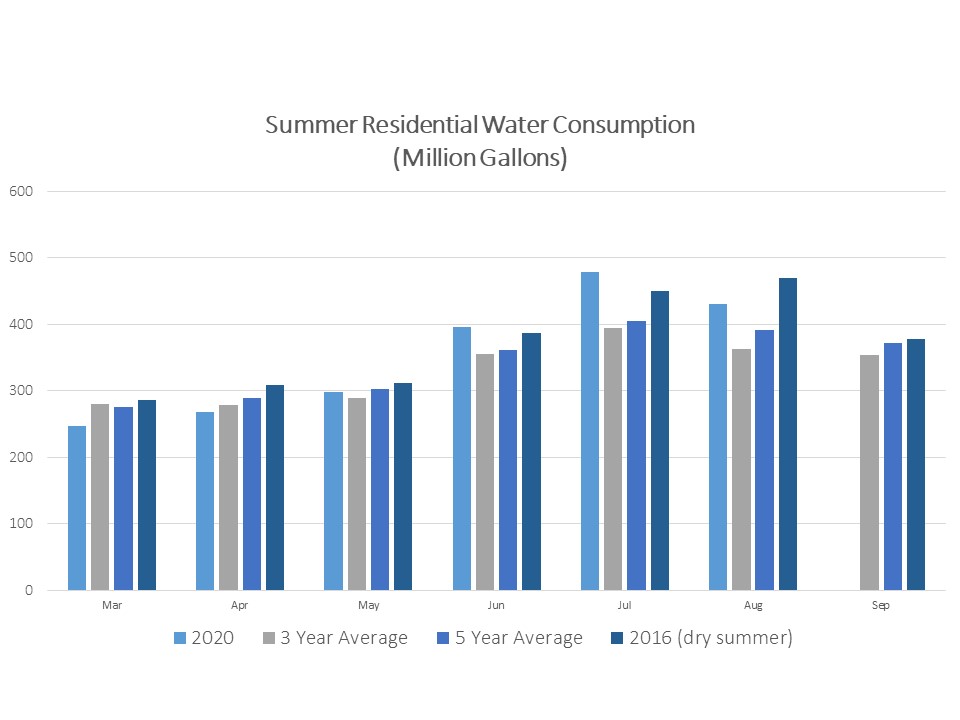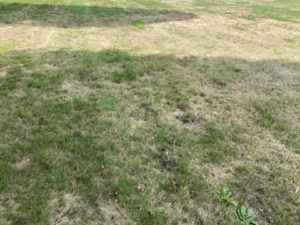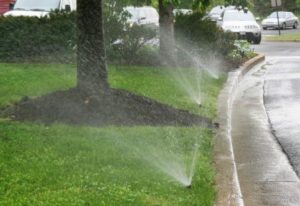When temperatures run high and the weather is dry, water consumption tends to rise. A large portion of increased water consumption in the summer months can be attributed to outdoor water use such as lawn watering, pools, and sprinklers. EPA estimates that outdoor water use can increase by as much as 30% in summer months.
The graph below shows how much water has been consumed by Commission customers in drier summers - with 2020 and 2016 as recent examples - compared to three- and five-year averages:

Save Water, Save Money on Your Lawn
According to EPA's WaterSense Program, watering the average-sized lawn for 20 minutes every day for 7 days is similar to running the shower constantly for 4 days, or 800 showers - which can mean 20,000 gallons of water (assuming 25 gallons per average 10 minute shower)!
And what does this mean in dollars and cents? 20,000 gallons is equivalent to 2,673 cubic feet of water a week. At current (Fiscal Year 2021) water and sewer rates, watering the average-size lawn for 20 minutes each day can cost as much as $265.46 per week.
The best way to save money on outdoor water use is to water efficiently. WaterSense notes that up to 50% of the water we use outdoors is lost due to wind, evaporation, and runoff caused by inefficient irrigation methods. Below are some lawn watering cost-saving tips:
Watering mid-day can result in a high rate of evaporation. The best time to water is early morning when temperatures are cooler.
Watering longer but less frequently promotes deep root growth, while watering for less time but more frequently promotes shallow root growth. Encouraging deep root growth will help your lawn better withstand dryer periods.
Lawns generally need 1″ of water per week to remain healthy. A quick trick is to place a tuna or cat food can in the range of your sprinkler to measure how much water has been dispersed each time you water. Water should soak 3-4″ into the soil to encourage deep root growth.
Note that the strength and output of sprinklers varies. This website offers a handy way to calculate how long you should water based on your particular sprinkler’s output (see section on Water-Wise Lawn Watering).
Finally, avoid applying fertilizer in summer – new growth needs more water. Apply fertilizer in early spring and fall when temperatures are lower.
It is natural for grass to become dormant during dry and hot spells, particularly in July and August. A brown lawn can indicate dormancy. Usually this is temporary and the lawn will revive naturally when cooler weather and/or more moisture arrives, so additional watering should not be necessary.

Letting your grass grow a little longer can go a long way. Taller grass provides its own shade and retains soil moisture better, as well as shading out potential weeds. Taller grass also encourages deeper root growth. Set your mower to its highest setting, and leave clippings on the lawn to serve as natural compost. A good rule of thumb is to never cut your lawn more than 1/3 of its height.
Sprinkler systems vary widely and should be tailored to your particular lawn as much as possible. Sprinklers should be placed so as not to spray water onto paved or other non-permeable surfaces, and to water at a low flow rate to allow for absorption.

Money down the (storm) drain…
Automatic sprinklers should be checked frequently for spray direction. Rain sensors can reduce watering during rainy periods. A licensed professional can help you determine the best irrigation system for your lawn.
Commission customers with in-ground irrigation systems may also install auxiliary meters to allow for a credit on the sewer portion of your bill for water used for irrigation purposes.
If you have an in-ground irrigation system installed to water your lawn, you may consider installing an auxiliary meter. Auxiliary (or secondary) meters measure how much water was used only for irrigation purposes, saving you money on sewer charges. Click here for more information.